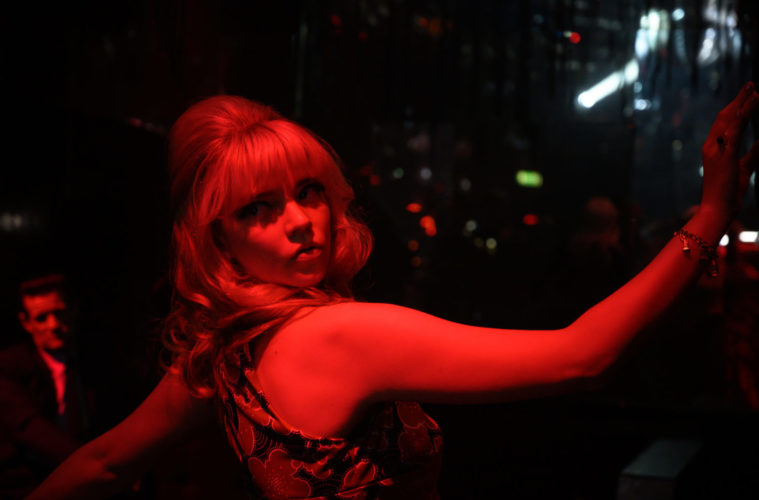 Taking a hard left turn from his usual route of bold, evocative comedies, Edgar Wright’s Last Night in Soho veers down a darker road. Much like his American counterpart, Quentin Tarantino, the British auteur makes films that pay homage to his influences even as they stretch conventions to a breaking point. He’s tackled almost every category: horror (Shaun of the Dead), action (Hot Fuzz), crime (Baby Driver) and most recently, music documentary (The Sparks Brothers). Now, he satiates his appetite for British thrillers like Peeping Tom and 70’s Italian Giallo films with his most audacious project yet.
Taking a hard left turn from his usual route of bold, evocative comedies, Edgar Wright’s Last Night in Soho veers down a darker road. Much like his American counterpart, Quentin Tarantino, the British auteur makes films that pay homage to his influences even as they stretch conventions to a breaking point. He’s tackled almost every category: horror (Shaun of the Dead), action (Hot Fuzz), crime (Baby Driver) and most recently, music documentary (The Sparks Brothers). Now, he satiates his appetite for British thrillers like Peeping Tom and 70’s Italian Giallo films with his most audacious project yet.
Visually, its a sumptuous and intoxicating journey. Not a horror film per se (at least, not a scary one), Wright does employ the genre’s tropes to tell a cautionary tale about the pitfalls of nostalgia, male toxicity and burying the past. The result is a hybridization of genres which is equally absorbing and frustrating. Wright is a master of visually engaging his audience, but the script needed one more draft to flesh out its threadbare characters. Still, it’s got a dizzying rhythm you can’t easily shake.
Eloise (Thomasin McKenzie) is an introverted teenager from the country who’s been accepted to fashion school in London. She’s also a nostalgist who’s enamored with London in the 60’s. She lives for The Kinks, Twiggy, Dusty Springfield, bouffant hairdos and jangly pop. When she’s not dancing in her bedroom to her 45’s or sketching 60’s-inspired dresses, she has visions of her schizophrenic mother who committed suicide when she was seven. Did the apple fall far from the tree? We shall see.
When Eloise arrives in London, things don’t pan out as she hoped. The city has an air of menace, she can’t seem to fit in with the other students and her roommate is a self-obsessed tart. She quickly moves out of the dorms and rents a room in a creaky house owned by an obstinate landlady, Miss Collins (Diana Rigg, in her final performance). In this decaying room, Eloise descends into a dreamlike wormhole of 1960’s Soho where she inhabits the skin of Sandie (Anya Taylor-Joy), an assertive bombshell who inhabited the room before her.
In this alternate universe, Eloise bears witness to her doppleganger’s downward trajectory. First, she watches Sandy get seduced by a handsome, albeit slimy club promoter (Matt Smith). Then she bears witness to Soho’s seedier side in the 60’s, where women like Sandie are exploited and their talents sucked dry by vampiric men. Suddenly, the past doesn’t look so sentimental. Although these Giallo-esque fantasies have a psychedelic opulence , we feel something dangerous lurking underneath their surface. These are by far the most potent moments in the film and you just wish Wright kept digging into their psychological underpinnings.
Initially these dreamscapes inspire Eloise. She dyes her hair blonde, excels at school and exudes confidence. However, as Sadie’s journey takes a dark turn in her dreams, Eloise begins to have nightmarish visions which seep into her daily life. Wright vacillates between these two worlds smoothly. His presentation of 60’s Soho is especially impressive. The set design, music, wardrobe and overall décor is not only wondrous, but speaks to the seductive nature of living in different era.
As Eloise becomes more consumed with Sandie’s predicament in the past, she starts investigating what happened to her in the present. And this is where the story runs out of steam. The first half of the movie is a swirling, psychedelic parable and a cinematic treat. Wright and his co-writer Krysty Wilson-Cairns also have a knack for addressing social issues without being too obvious about it. However, the narrative cannot sustain the thin plot, which results in too many supernatural “scare” sequences, which are more reminiscent of the Insidious series than Hammer. A part of you wishes that Wright continued harnessing the psychological mystery from the vintage horror films he loves and discarded the visual effects.
Much like the recently released The French Dispatch, which solely relies on its own elegance and design to entertain us, this movie favors style over plot and character. The difference however lies in how the directors approach their material. While Wes Anderson requires a secret handshake to enter his domain, Wright’s passion to connect with his audience and pull them into his imagination is palpable and thrilling; and it has a modicum of emotional currency. The actors also bring a lot to an already visually stunning tableau.
McKenzie’s turn as Eloise could’ve easily felt forced, even corny, but she injects some genuine emotion into a role that requires gawking and screaming a lot. However, even with a secondary part, this is Taylor-Joy’s (The Queen’s Gambit) movie. You can’t take your eyes off her. She’s equal parts obstinate, vulnerable and wistfully tragic. Hollywood has definitely discovered a modern Audrey Hepburn. It’s also a joy to see iconic talents like Rigg and Terrence Stamp act their hearts out. There’s no doubt that Last Night In Soho gets a little high on its own stylistic panache but Wright’s obsessive fervor for the subject makes it an original and worthy experience.
Advertising disclosure: We may receive compensation for some of the links in our stories. Thank you for supporting LA Weekly and our advertisers.

